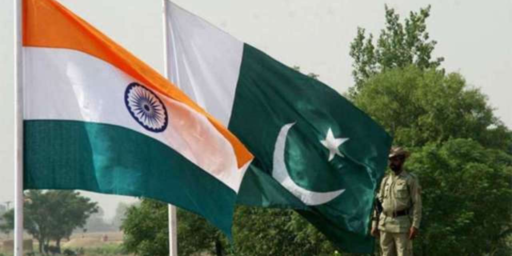Why We Need the F-22 Raptor
David Axe provides the first persuasive argument that I’ve seen for further acquisition of the F-22 Raptor fighter. Since the Cold War ended, most of us have argued that continued reliance on the F-15/F-16 platform was more than adequate given the state of our adversaries. Why not just roll out next-generation versions of those planes with state-of-the-art avionics?
Axe argues that “the latest Sukhoi Su-27 Flanker derivate fighters and ‘double-digit’ surface-to-air missile systems such as the S-300” have largely obviated that argument. Even conceding that “the F-15 and F-16 might be equal or even slightly superior (when pilot training, weapons and joint and industry support are considered),” we are fast losing automatic air dominance. It’s not just theoretical, when one takes a look at who has these systems:
S-300: Armenia, Belarus, Bulgaria, China, Cyprus, Hungary, India, Iran, Kazakhstan, Russia, Slovakia, Syria, Ukraine and Vietnam
Su-27/30/33: Angola, Armenia, Belarus, China, Ethiopia, India, Indonesia, Kazakhstan, Malaysia, Mexico, Russia, Syria, Ukraine, Uzbekistan, Venezuala (rumored) and Vietnam
The other alternative, the F-35 Lightning, is not the answer, either:
While a fine bomb-hauler and (one hopes) a good multi-service airframe, the F-35 is a mediocre performer. Said 1st Fighter Wing commander Brigadier General Burton Field, “The problem with the F-35 … is speed. It doesn’t have the capability to supercruise. Speed lets us get inside the decision cycle of the bad guy.”
For the most dangerous air battles and attack missions, F-35 squadrons will rely on F-22s for support. That’s an unavoidable state of affairs when you design an airframe to replace slow- and low-flying Lockheed Martin A-10 Warthogs and Boeing AV-8B Harriers as well as light and flexible F-16s and Boeing F/A-18 Hornets. The F-35 is a compromise. Potentially a very successful compromise, but still …
We’ve already sunk $25 billion into Raptor development. That money is irrecoverable. Further jets cost only around $115 million (perhaps twice as much as a new F-16) and will get even cheaper. We should get a good return on our investment. A good return, in my estimation, means a full fleet of at least 381 Raptors in 10 or more full-strength squadrons. That should guarantee air dominance for another 30 years or more.
Which, incidentally, is about the age of our F-15/F-16 fleet.
I’m a systems guy, not a tech guru, so I’m not the best source on this. My general tendency is to be suspicious when the Air Force wants a new toy, because they always want a new toy (see the works of the late Carl Builder, especially Masks of War, for much more on that). But this debate is worth taking seriously.
UPDATE: Russell Newquist makes some good points about the leapfrog effect for high tech inventions.





The logical followup to this argument is: Why are we wasting more money on hugely expensive manned systems when UCAVs are just around the corner? I know the naysayers will say that UCAV technology isn’t up to fight manned fighters. But give it enough R&D funds and I’m sure we can solve that problem quickly. BTW, did you catch that Lockheed is now pushing the F-35 with unmanned capability?
Being an ex-USAF officer (non-rated), I’m highly cynical of the fighter pilot mafia’s true motivations. They’ll actively sabotage any attempt to develop UCAV technology if they are given the lead for the project.
The UCAV discussion is a good one, but it would be the replacement to the F22, not this generation of replacement. Lots of good discussion to be had on whether or not to have a human directly in the loop.
But for those who are complaining about the casualty rate in Iraq, the F22 should be a no brainer. You can’t suggest that we send the military in if we know that we could have saved lives with a better plane. Right now a lot of the US military options comes from the fact that if we don’t have air superiority we can get it. That doesn’t obviate the need for the boots on the ground, but imagine the cost in lives of any military action where we didn’t have air superiority.
There’s been a lot of good discussion about the F-22 at the 1 FW at Langley AFB over at http://www.defensetech.org
I have to agree with YAJ on this one – UCAVs are definitely on the menu, but given the age of our current gear, we can’t wait until they’re mature and move directly from F-16/16/18s to that.
Controlling the “high ground” is a critical first step in any military operation; as expensive as the F-22 is, it’s much cheaper (by many measures) than spending the extra grunts’ lives needed to win without it.
Now, whether or not we need the F-35 vs. giving a lot more TLC (and $$) to A-10s is a debate that would _really_ be interesting…
“Why are we wasting more money on hugely expensive manned systems when UCAVs are just around the corner?”
Wow, how to answer that without seeming jaded and cynical?
As an AF MSgt with 22 years of service, I have to tell you the answer is simple. In the Air Force, there are fighter pilots and there are all others. For the current generation of leadership to stand up and admit that an unmanned aircraft can do the same job as a manned one would take a huge shift in mental and emotional momentum. That would take a Hap Arnold moment. (General Arnold was an advocate for air power when the Army Air Corps was still looking at aircraft as simply a recon platform, not an offensive or defensive weapons system.)
Most of your senior leaders in the Air Force are fighter pilots. Their friends are fighter pilots. As far as they’re concerned fighter pilots are the be all and end all of this branch of he service. They are our raison detre…unless of course you’re in missiles and that’s another story entirely.
Granted, we don’t have the air to air skirmishes of yesteryear, but the fact that they still fly close ground support missions makes them the royalty of the Air Force.
Seriously, before we even think of developing an unmanned fighter/bomber, there’s going to have to be a threat of another nation developing a UAV that can out-maneuver a manned fighter of ours.
I’m afraid we’re going to have to lose some good young men to a machine before we make it happen.
The interesting thing, for me anyway, is how we’re paying for the new toys. Another 40,000 people slashed by the end of 2010. Almost all of our support functions are being contracted out.
…which is basically what DC Loser said but less politic.
But that’s why they pay NCOs the big bucks, to say the things officers can’t/won’t say.
Timmer, you said it great. I always had a tremendous respect for NCOs.